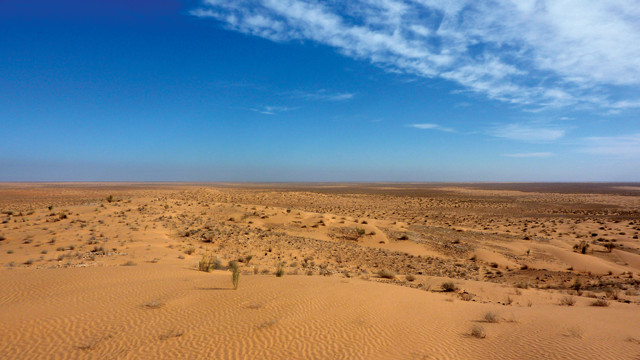
by Adityarup "Rup" Chakravorty Tuesday, April 18, 2017

Thousands of years ago, the Sahara was dotted with lakes and vegetation. Credit: Wonker, CC BY 2.0.
Six thousand years ago, the Sahara — today the world’s largest nonpolar desert, stretching over an area larger than the contiguous United States — was dotted with lakes and vegetation. Rock paintings from that time depict a much wetter landscape, and show elephants, hippos, antelope and many other animals living in the region.
Researchers have theorized that a northward shift of the equatorial rain belt caused by warmer summers in the Northern Hemisphere — due to more solar energy hitting the hemisphere relative to today — was responsible for the greening of the Sahara several thousand years ago. But a new study in Nature Geoscience indicates that west-to-east shifts in tropical rainfall and decreased surface albedo over the Sahara and Europe might have also played a vital role in creating a more verdant Saharan landscape in the past.
In addition to the prehistoric paintings, geologic evidence of increased rainfall in the Sahara thousands of years ago also exists. But “global climate models haven’t been able to reconcile a northern shift of tropical rainfall” with this evidence, says Robert Korty, a climatologist at Texas A&M University and co-author of the study.
The problem is that “although we have a good idea of how the global average of tropical rainfall changed in the past with variations in solar insolation, we don’t know very much about how rainfall shifted in any specific region,” says David McGee, an atmospheric scientist at MIT who was not involved with the study.
To address this issue, Korty and William Boos of Yale University developed a quantitative framework that linked local fluctuations in Earth’s energy balance to changes in regional rainfall.
When air is heated by solar energy, it can hold more water. As warm, moist air rises, it cools, causing water vapor to condense into clouds and precipitation. Today, warm air rising close to the equator — about 1,600 kilometers south of the Sahara’s southern edge — absorbs large amounts of water from the ocean, which subsequently results in heavy rainfall over most of the tropics.
The same process played out 6,000 years ago, but Earth’s energy balance at that time was different than it is today. Much like a spinning top, Earth wobbles on its axis as it rotates. These wobbles cause changes in the amount of solar insolation that strikes each hemisphere; 6,000 years ago, the Northern Hemisphere received roughly 7 percent more solar insolation in July than it does today. The increased influx of solar energy caused warmer summers in the Northern Hemisphere and shifted the tropical rain belt northward as well, but only by a couple of degrees of latitude on average, according to climate models. This was not enough to explain the increased precipitation over the Sahara, Korty says. “The next logical step was to look at longitudinal shifts in rainfall.”
Korty and Boos studied how a well-known modern weather pattern — the El Niño-Southern Oscillation (ENSO) — affects tropical rainfall. During ENSO warm phases, temperatures at the surface of the equatorial eastern and central Pacific Ocean are anomalously high. Although little change in the average latitude of tropical rainfall occurs due to this warming, the zone of highest precipitation shifts significantly eastward by about 20 degrees longitude.
“We have ample data on ENSO and the modern climate, and that allowed us to test our ideas and framework,” Korty says.
Korty and Boos calculated that the increased solar insolation during Northern Hemisphere summers 6,000 years ago would have heated the air over land masses more so than the air over oceans — because the oceans absorb more heat — such that the prevailing tropical rainfall patterns would have shifted northeastward and closer to the Sahara.
Still, incorporating regional differences in the planet’s energy balance into their calculations wasn’t enough to match the higher Saharan rainfall indicated in the geologic record. “We had to examine other factors that may have contributed to increased rainfall,” Korty says.
One such factor the researchers considered was a change in albedo of the land surface. “Forests in Europe and plant life in the Sahara, along with the darker color of moister soils, could all have contributed to lower surface albedo and higher rainfall,” Korty says. When lower surface albedo is included in calculations, rainfall shifts over the Sahara are more similar to what’s seen in the geologic record.
“Other factors, such as agriculture or irrigation systems in the Sahel and sub-Saharan areas, cloud cover and transpiration, and mineral dust in the atmosphere, could also have affected regional rainfall,” McGee adds.
The findings of the work offer “a new way to answer an old question” about how the Sahara could have been so much greener than today, Korty says. Applying similar analyses, he notes, “could be useful for studying tropical rainfall — such as the monsoons of southern Asia or precipitation in Australia — in more modern contexts as well.”
© 2008-2021. All rights reserved. Any copying, redistribution or retransmission of any of the contents of this service without the expressed written permission of the American Geosciences Institute is expressly prohibited. Click here for all copyright requests.